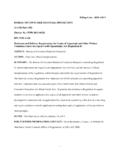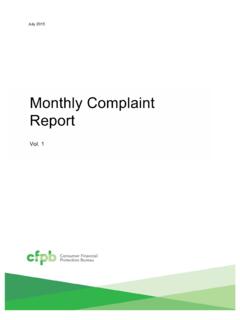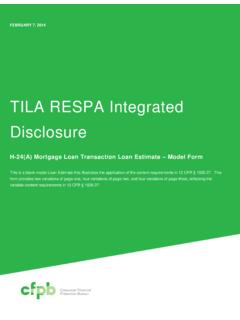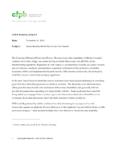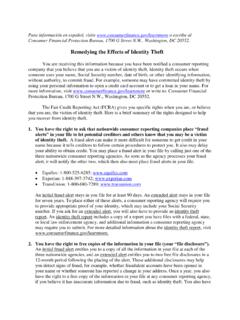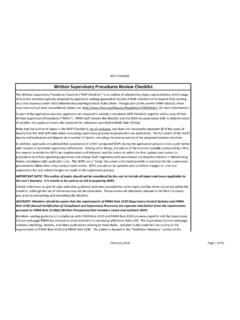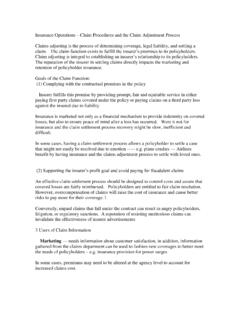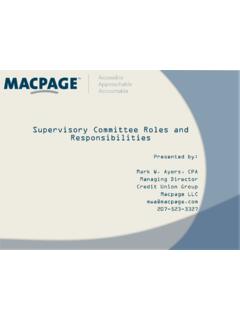Transcription of CFPB Examination Procedures CMR-IT
1 CFPB Examination Procedures CMR-IT CFPB September 2021 CMR-IT 1 Compliance Management Review Information Technology ( CMR-IT ) General Principles and Introduction Institutions1 within the scope of the CFPB s supervision and enforcement authority include both depository institutions and non-depository consumer financial services companies. Th ese institutions operate in a dynamic environment influenced by challenges to profitability, increased focus on outcomes to consumers, industry consolidation, advancing technology, market globalization, and changes to laws and regulations. To remain competitive and responsive to consumer needs in such an environment, institutions continuously assess their business strategies and modify product and service offerings and delivery channels. To maintain legal compliance, an institution should develop and maintain a sound compliance management system (CMS) that is integrated into the overall framework f or product design, delivery, and administration across its entire product and service lif e cycle.
2 Ultimately, compliance should be part of the day-to-day responsibilities of management and the employees of a supervised entity. Issues should be self-identified, and corrective action should be initiated by the entity. Institutions are also expected to manage relationships with service providers to ensure that service providers effectively manage compliance with Federal consumer financial laws applicable to the product or service being Institutions of ten use information technology (IT) that could imp act compliance with Federal consumer financial laws. As part of its overall CMS assessment, the CFPB may evaluate the technology controls of an institution and its service providers. The CFPB may also evaluate an institution s IT as it relates to compliance with Federal consumer f inancial laws. The Compliance Management System Inf ormation Technology (CMS-IT) Examination Procedures set f orth below are used by examiners to assess IT and IT controls as part of a CMS review.
3 A CMS is how an institution: Establishes its compliance responsibilities; Communicates those responsibilities to employees; Ensures that responsibilities f or meeting legal requirements and internal policies and Procedures are incorporated into business processes; 1 The terms institution and entity are used interchangeably throughout this document. 2 See CFPB Bulletin 2016-02, Service Providers (October 31, 2016), which describes the CFPB s expectation that supervised banks and nonbanks oversee their business relationships with service providers in a manner that ensures compliance with Federal consumer financial law. Compliance Bulletin and Policy Guidance; 2016-02 Exam Date: [Click&type] Exam ID No. [Click&type] Prepared By: [Click&type] Reviewer: [Click&type] Supervision ID #: [Click&type] Entity Name: [Click&type] Event #: [Click&type] CFPB Examination Procedures CMR-IT CFPB September 2021 CMR-IT 2 Reviews operations to ensure responsibilities are carried out and legal requirements are met; and Takes corrective action and updates tools, systems, and materials as necessary.
4 An effective CMS commonly has two interdependent control components: Board and Management Oversight; and Compliance Program, which includes: Policies and Procedures ; Training; Monitoring and/or audit; and Consumer complaint response. When the two interdependent control components are strong and well-coordinated, an institution typically is successf ul at managing its compliance responsibilities and risks. Additionally, the Bureau s supervisory expectations with respect to an institution s compliance program extend to service provider relationships into which the institution has entered. Th ere can be certain benef its to institutions engaging in relationships with service providers, including gaining operational efficiencies or an ability to deliver additional products and services. However, such arrangements may also expose institutions to risks when not managed properly.
5 While an institution s management may make the business decision to outsource some or all of the operational aspects of a product or service, the institution cannot outsource the responsibility for complying with Federal consumer financial laws or managing the risks associated with service provider relationships. Weaknesses in a CMS can result in violations of Federal consumer financial law and associated harm to consumers. Therefore, the CFPB expects every institution under its supervision and enforcement authority to have a CMS adapted to its business strategy and operations. The CFPB understands that compliance will likely be managed differently by large banking organizations with complex compliance profiles and a wide range of consumer financial products and services3 at one end of the spectrum, than by non-bank entities that may be owned by a single individual and feature a narrow range of financial products and services, at the other end of the spectrum.
6 Compliance may be managed on an enterprise-wide basis, and institutions may engage outside firms to assist with compliance management. However compliance is managed, a provider of consumer financial products or services under CFPB s supervisory purview is expected to comply with Federal consumer financial laws and appropriately address and limit violations of law and associated harms to consumers. 3 For example, the Federal Reserve Board of Governors expects large banking organizations with complex compliance profiles to implement firm-wide compliance risk management programs and have a corporate compliance function. SR 08-8 / CA 0 8-11, October 16, 2008. The CFPB will expect no less. CFPB Examination Procedures CMR-IT CFPB September 2021 CMR-IT 3 The CFPB also understands that institutions will organize their CMS to include compliance with consumer-related state and Federal laws that are outside the scope of the CFPB s supervision responsibilities, in addition to the matters that are within the CFPB s scope.
7 The CFPB, therefore, expects that CMS be organized within a firm, legal entity, division, or business unit in the way that is most ef f ective to the institution, and that the manner of organization will vary f rom institution to institution. This CMS Examination manual is divided into f ive Modules: Module 1: Board and Management Oversight Module 2: Compliance Program Module 3: Service Provider Oversight Module 4: Violations of Law and Consumer Harm Module 5: Examiner Conclusions and Wrap-Up Module 1: Board and Management Oversight In a depository institution, the board of directors is ultimately responsible for developing and administering a CMS that ensures compliance with Federal consumer f inancial laws and addresses and minimizes associated risks of harm to consumers. In a non-depository consumer financial services company, that ultimate responsibility may rest with a board of directors in the case of a corporation or with a controlling person or some other arrangement.
8 For the balance of this section of the Manual, references to the board of directors or board generally refer to the board of directors or other individual or group exercising similar oversight functions. In addition, some institutions may be governed by firm-wide standards, policies, and Procedures developed by a holding company or other top-tier corporation for adoption, use, and modif ication, as necessary, by subsidiary entities. In the absence of a board of directors and board committee structure, the examiner should determine that the person or group exercising similar oversight functions receives relevant information about compliance and consumer protection matters and takes steps to ensure that the key elements, resources, and individuals necessary for a CMS commensurate with the supervised entity s risk profile are in place and functioning.
9 Under Board and Management Oversight, examiners should assess the institution s board of directors and management, as appropriate, for their respective roles and responsibilities, based on the f ollowing f actors: Oversight of and commitment to the institution s CMS; Effectiveness of the institution s change management processes, including responding in a timely manner and satisfactorily to any variety of change, internal or external, to the institution; CFPB Examination Procedures CMR-IT CFPB September 2021 CMR-IT 4 Comprehension, identif ication, and management of risks arising f rom the institution s products, services, or activities; and Self-identification of consumer compliance issues and corrective action undertaken as such issues are identified. Board and Management Oversight Examination Objectives Since the effectiveness of a CMS is grounded in the actions taken by its board and senior management, examiners should seek to determine whether the board and management meet the f ollowing objectives: Oversight of and Commitment to the Institution s CMS 1.
10 Demonstrate a strong commitment and oversight to the institution s CMS. 2. Provide compliance resources including systems, capital, and human resources commensurate with the institution s size, complexity, and risk profile. 3. Ensure that staff is knowledgeable, empowered and held accountable f or compliance with Federal consumer financial laws. 4. Conduct comprehensive and ongoing due diligence and oversight of service providers consistent with the CFPB s expectations to ensure that the institution complies with Federal consumer financial laws. 5. Exercise oversight of service providers policies, Procedures , internal controls, and training to ensure consistent oversight of compliance responsibilities. Change Management 1. Respond promptly to changes in applicable Federal consumer financial laws, market conditions, and products and services offered by evaluating the change and implementing responses across impacted lines of business.
